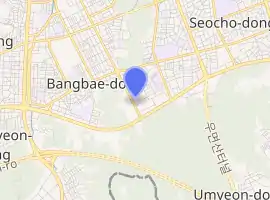National Gugak Center
The National Gugak Center, located in Seoul, South Korea, is the primary institution of learning for Korean traditional music (gugak), including both court music and folk music.[1]
 | |

| |
| Former names | The National Center for Korean Traditional Performing Arts |
|---|---|
| Location | Seocho-dong, Seocho-gu, Seoul, South Korea |
| Coordinates | 37°28′39.50″N 127°0′3″E |
| Type | Performing arts center |
| Genre(s) | Traditional Korean music (gugak) |
| Opened | January 19, 1950 |
| Website | |
| gugak | |
| Korean name | |
| Hangul | |
|---|---|
| Hanja | |
| Revised Romanization | Gungnip Gukagwon |
| McCune–Reischauer | Kungnip Kugagwŏn |
Successor to the Eumseongseo music institute of the Silla kingdom in the 7th century, the National Center for Korean Traditional Performing Arts was founded under its present Korean name in 1950. The English name was officially shortened to the National Gugak Center in 2010.[1]
It is dedicated to "preserving and promoting traditional Korean music."[2] Through academic courses, private study, ensembles, research, and performances, it preserves Korea's ancient musical traditions, including the ancient court ritual music called aak as well as the ritual music performed for the Jongmyo (royal ancestral shrine) and the Munmyo (Confucian shrine).
In 2018, the organization added fifty more types of sounds and instruments to their repertoire as the pop song "Idol", which includes some gugak instruments.[3]
See also
References
- Reily, Suzel Ana; Dueck, Jonathan M. (2016). The Oxford Handbook of Music and World Christianities. Oxford University Press. p. 635. ISBN 978-0-19-986000-5.
the National Center for Korean Traditional Performing Arts (Kungnip kugagwŏn; the English name was in 2010 somewhat myopically changed to the National Gugak Center). [...] [Director] Han was keen to broaden its activities, from its former role as repository of court music to an institute embracing folk music and dance.
- Kim, Soo-yeong (December 26, 2018). "국립국악원, 국악기 디지털 음원 서비스 확대…"방탄소년단 히트곡 영향"". Naver (in Korean). KBS. Retrieved December 28, 2018.
